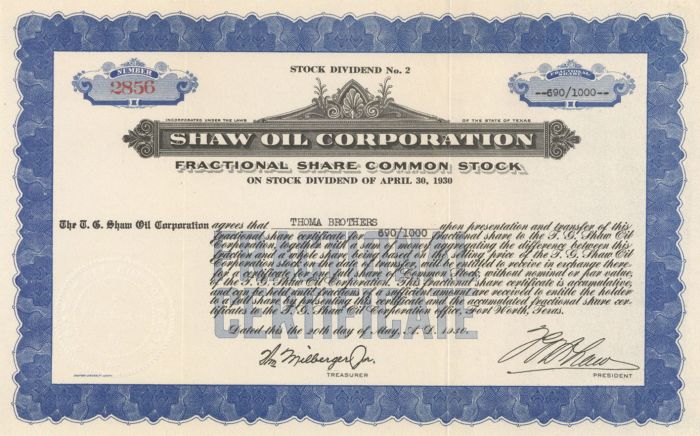Shaw Oil Corporation - Stock Certificate
Inv# OS1838 Stock
Stock printed by Stafford-London, Fort Worth.
Petroleum, in one form or another, has been used since ancient times, and is now important across society, including in economy, politics and technology. The rise in importance was due to the invention of the internal combustion engine, the rise in commercial aviation, and the importance of petroleum to industrial organic chemistry, particularly the synthesis of plastics, fertilisers, solvents, adhesives and pesticides.
More than 4000 years ago, according to Herodotus and Diodorus Siculus, asphalt was used in the construction of the walls and towers of Babylon; there were oil pits near Ardericca (near Babylon), and a pitch spring on Zacynthus. Great quantities of it were found on the banks of the river Issus, one of the tributaries of the Euphrates. Ancient Persian tablets indicate the medicinal and lighting uses of petroleum in the upper levels of their society.
The use of petroleum in ancient China dates back to more than 2000 years ago. The I Ching, one of the earliest Chinese writings, cites that oil in its raw state, without refining, was first discovered, extracted, and used in China in the first century BCE. In addition, the Chinese were the first to record the use of petroleum as fuel as early as the fourth century BCE. By 347 CE, oil was produced from bamboo-drilled wells in China.
Crude oil was often distilled by Persian chemists, with clear descriptions given in Arabic handbooks such as those of Muhammad ibn Zakarīya Rāzi (Rhazes). The streets of Baghdad were paved with tar, derived from petroleum that became accessible from natural fields in the region. In the 9th century, oil fields were exploited in the area around modern Baku, Azerbaijan. These fields were described by the Arab geographer Abu al-Hasan 'Alī al-Mas'ūdī in the 10th century, and by Marco Polo in the 13th century, who described the output of those wells as hundreds of shiploads. Arab and Persian chemists also distilled crude oil in order to produce flammable products for military purposes. Through Islamic Spain, distillation became available in Western Europe by the 12th century. It has also been present in Romania since the 13th century, being recorded as păcură.
Sophisticated oil pits, 4.5 to 6 metres (15 to 20 ft) deep, were dug by the Seneca People and other Iroquois in Western Pennsylvania as early as 1415–1450. The French General Louis-Joseph de Montcalm encountered Seneca using petroleum for ceremonial fires and as a healing lotion during a visit to Fort Duquesne in 1750.
Early British explorers to Myanmar documented a flourishing oil extraction industry based in Yenangyaung that, in 1795, had hundreds of hand-dug wells under production.
Pechelbronn (Pitch fountain) is said to be the first European site where petroleum has been explored and used. The still active Erdpechquelle, a spring where petroleum appears mixed with water has been used since 1498, notably for medical purposes. Oil sands have been mined since the 18th century.
In Wietze in lower Saxony, natural asphalt/bitumen has been explored since the 18th century. Both in Pechelbronn as in Wietze, the coal industry dominated the petroleum technologies.
A stock certificate is issued by businesses, usually companies. A stock is part of the permanent finance of a business. Normally, they are never repaid, and the investor can recover his/her money only by selling to another investor. Most stocks, or also called shares, earn dividends, at the business's discretion, depending on how well it has traded. A stockholder or shareholder is a part-owner of the business that issued the stock certificates.










Ebay ID: labarre_galleries